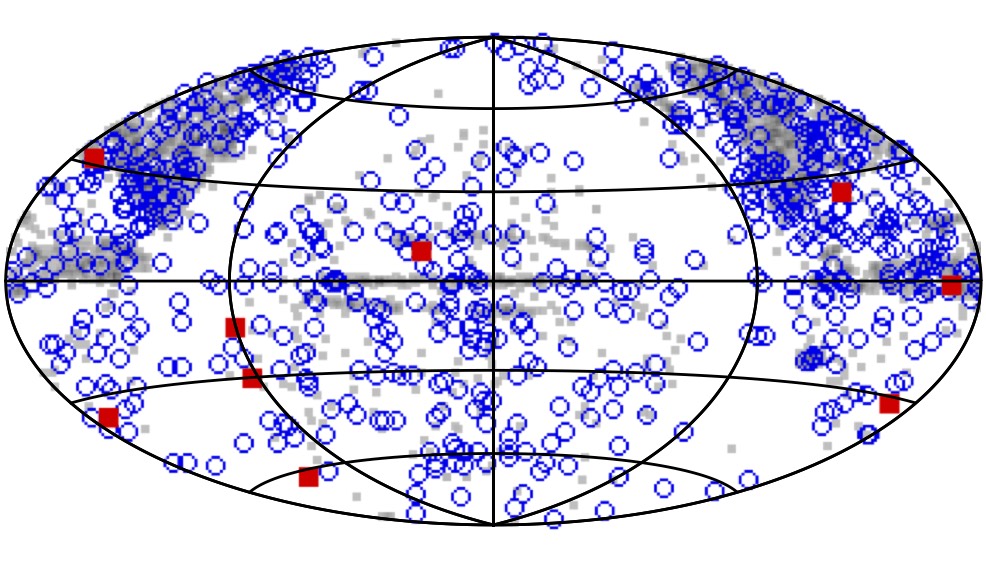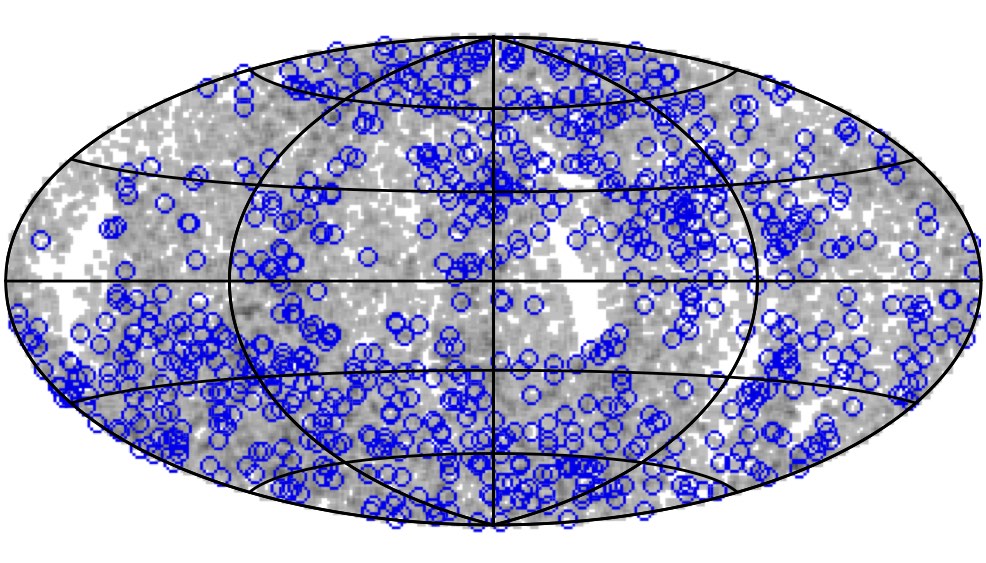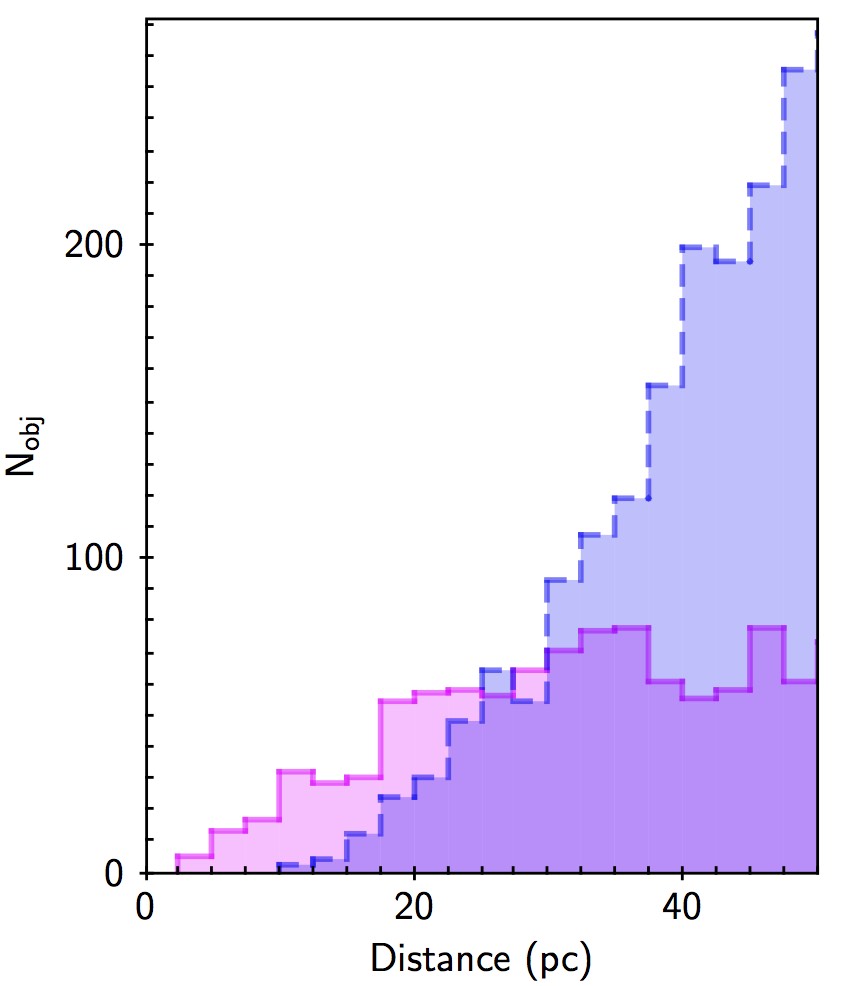IoW_20181126 - Gaia
Image of the Week |
New very low mass dwarfs in Gaia data |
|
Figure 1: Sky distribution of previously known (top) and uncatalogued (bottom) Very Low Mass dwarfs in Gaia data. Gray dots indicate sources with measured / estimated spectral types > M7, blue circles are L dwarfs, red circles are T dwarfs (Gaia is not particularly sensitive to late-L and T dwarfs; Smart et al. 2017; Theissen 2018). The new sample is far more spatically uniform with greater north/south symmetry and better sampling of the Galactic plane. |
|
Detailed population studies of Very Low Mass (VLM) dwarfs are persistently plagued by incompleteness. While hundreds of VLM dwarfs have been uncovered in red and infrared sky surveys, this population remains incomplete, even within 30 parsec, due to their faint magnitudes. The Gaia mission has provided the means to uncover nearby VLM dwarfs through astrometric, rather than purely photometric, selection. This holds the promise of a truly volume-complete sample. The work "New ultra-cool and brown dwarf candidates in Gaia DR2" by Céline Reylé is the first systematic search of VLM dwarfs in Gaia Data Release 2, identifying nearly 14,000 previously uncatalogued VLM candidates in the very precise Gaia DR2 Herztsprung-Russel diagram. These include 100s of potentially young (anamolously bright) or metal-poor (anamolously blue) sources. Over 200 candidates have measured distances of less than 30 parsec, showing that even the nearby census is not complete, and are evenly distributed across the sky, filling in “missing” populations in the Southern hemisphere and Galactic plane. The Very Low Mass dwarfs populate the low-mass end of the main sequence in the Herztsprung-Russel diagram (spectral type > M7, mass<~0.5 solar mass). These objects serve as a link between known stars (with H-burning in their core) and brown dwarfs (without H-burning in their core), as they span the stellar/sub-stellar mass transition (the H-burning limit, around 0.075 solar mass). They are the dominant component of the Milky Way (~70% of all stars). For this reason, they are key probes in several Galactic studies. Moreover, they are now known to host exoplanets, including super-Earth exoplanets (for example the newly discovered exo-Earth around Ross 128). Yet they remain elusive due to their low luminosity, and the modeling of their cool (temperatures of less than about 2700K) and complex atmosphere is still a challenge. The determination of accurate fundamental parameters for VLM dwarfs has therefore relevant implications for both stellar and Galactic astronomy, and for searches for potentially habitable terrestrial exoplanets. A spectral survey of the nearby candidates (within 30 parsec) was proposed as part of an international collaboration using multiple facilities (VLT, Gemini North and South) in order to confirm their nature, obtain classifications, measure radial velocities, and analyse diagnostics of magnetic activity, metallicity, and surface gravity. These observations will significantly improve our census of local VLM dwarfs, which will serve as key targets in cool atmosphere, Galactic population, and exoplanet studies. Figure 2: Distribution of known Very Low Mass dwarfs (pink histogram) with distance measured by Gaia and new Gaia candidates (blue histogram). Incompleteness is apparant in the known population even at 20 parsecs. Not that this is not the full sample, but shown only to 50 parsecs. Image credit: C. Reylé. |
|
Credits: ESA/Gaia/DPAC, C. Reylé [Published: 26/11/2018] |
- Removed a total of (7) style text-align:center;
- Removed a total of (5) style text-align:justify;
- Removed a total of (1) border attribute.
- Removed a total of (1) cellpadding attribute.
- Removed a total of (1) cellspacing attribute.
Image of the Week Archive
- Removed a total of (1) border attribute.
- Removed a total of (1) cellpadding attribute.
- Removed a total of (1) cellspacing attribute.








































 Sign in
Sign in
 Science & Technology
Science & Technology


